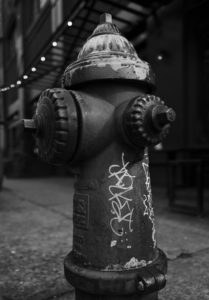This was day 5 of our trip from Vancouver to Tijuana and our longest drive. We had to cover some 400 miles, mostly on twisting two lane highways, from our lodge near Gold Beach on the Oregon coast to San Francisco, a journey which would take more than 7 hours – if we didn’t stop. This was also to be our day amongst the Giant Redwoods. Initially, our progress was slow as we were constantly distracted by the views from the coast road. Most of the time we were able to pull over in a layby, but to view Arch Rock, a massive rock formation along one of the most rugged sections of the Oregon coast, we needed to park up and walk a short trail.
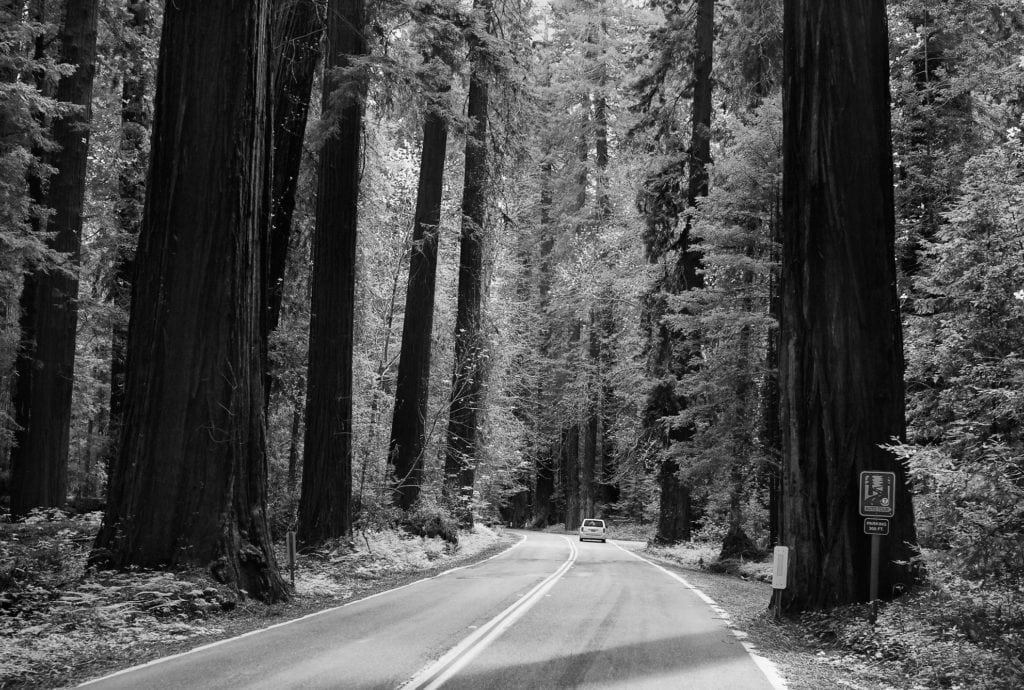 First Sight of The Redwoods
First Sight of The Redwoods
Stopping at the mysteriously named Trees of Mystery, located at Klamath, California, we were greeted by a very kitsch 49 foot tall Paul Bunyan, a giant lumberjack of American folklore, and his proportionally large Blue Ox, Babe. Whilst these are really very large statues (most visitors would not reach Babe’s knee), they did not prepare us for the sheer scale of the Giant Redwoods we saw as we walked the trails. Whilst they are the world’s largest single trees, they are also both the largest and oldest living things on Earth. These incredible trees can also be viewed from the top of the forest via a gondola ride, though personally I found their majesty was best appreciated at ground level.
Taking the opportunity for brunch, we visited the Forest Cafe just across the road. Unsurprisingly, it was forest themed and even more kitsch than the statues. One of the specialities there is local dish called a Monte Cristo, which we sampled . This is an XXL French toast sandwich, filled with ham and Swiss cheese, fried, dusted with icing sugar, and served with side of hash browns. I think of it as the Mr Creosote of Croque-monsieurs.
The Avenue of the Giants
The next waypoint on our trip had the advantage of being one we could see without stopping – in theory at least. This was the Avenue of the Giants, actually State Highway 254, which we entered from the northern end a few miles south of the town of Fortuna, and is pictured here. The road was once was part of Route 101 until it was bypassed in the 1960s. It was an incredible driving experience; the highway is lined with magnificent Coast Redwoods and runs parallel to a small and picturesque river.
Coast Redwoods (aka California redwoods) are also astonishingly large. Curiously, the height these redwoods can attain is related to the availability of fog. This is because transporting water to such great heights by conventional means is extremely difficult and the upper leaves supplement their water supply by extracting it from fog.
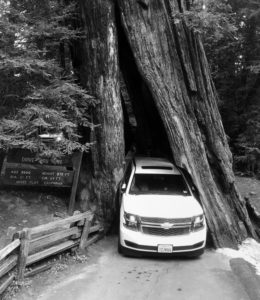 Along the route there is a drive-through Redwood, and it seemed unreasonable not to sample it, especially as, unlike other examples, the opening in the trunk is natural. As we paid for our $8 ticket (the tree is privately owned), we were told that our Chevy Suburban was the very largest vehicle the Shrine Drive-Thru Tree could accommodate. Nick drove, I assisted from the passenger side and Ted took photos of the unlikely sight of a huge SUV passing through a tree. At points there was barely an inch to spare either side, but the paint was still all on the car as we exited.
Along the route there is a drive-through Redwood, and it seemed unreasonable not to sample it, especially as, unlike other examples, the opening in the trunk is natural. As we paid for our $8 ticket (the tree is privately owned), we were told that our Chevy Suburban was the very largest vehicle the Shrine Drive-Thru Tree could accommodate. Nick drove, I assisted from the passenger side and Ted took photos of the unlikely sight of a huge SUV passing through a tree. At points there was barely an inch to spare either side, but the paint was still all on the car as we exited.
Shoreline Highway
From the Avenue of the Giants it is just 30 miles or so to California State Route 1, also known as the Pacific Coast Highway (PCH) and the inspiration for our trip. North to South, it runs 750 miles inland from Leggett, in northern Mendocino, along the coast to Capistrano Beach, which is about 50 miles South of Long Beach. The stretch we were on passes through Mendocino, Sonoma and Marin Counties and is known officially Shoreline Highway until it reaches the Golden Gate Bridge at Sausalito.
The Shoreline Highway is a beautiful but slow, windy stretch of two-lane blacktop that hugs the coast. it is not what most people think of as the PCH, which is the section that runs between San Luis Obispo and Monterey, passing through Big Sur, Carmel and Monterey. I read online that the drive between Leggett and Sausalito could be done in a day, ‘but it would be a tiring one’. This amused me somewhat as we were already 5 hours into our drive at Leggett.
 Golden Gate Bridge
Golden Gate Bridge
After about 3 hours we arrived at Sausalito, cheering in unison as we caught sight of San Francisco’s most famous landmark, the Golden Gate Bridge, resplendent in International Orange. Ted knew of some places with good views up in the Marin headlands just north of bridge, so we headed under the 101 and up a narrow winding road, which you can see in the photo.
Whilst there are many places to shoot the bridge from this is actually one of the best vantage points in the late afternoon or early evening. Parking, however, at one of the few designated areas, is really difficult. Once parked up we enjoyed a great view of this truly amazing piece of engineering. It was constructed in the 1930s and had to overcome wind, fog, deep water, tides and vested interests opposed to its construction to span the Golden Gate strait. At that time, at 746 high the towers were taller than any building in the city of San Francisco.
J Town, San Francisco
I love Japan, so I was excited to be staying at the Hotel Kabuki in the J Town (aka Japantown and Nihonmachi) part of San Francisco that evening. This affection for all things Japanese had only become stronger since my 10 day roadtrip across the country the previous year. There are far fewer Japan Towns than China Towns in the USA, with just 3 versus around 50. San Francisco’s is both the largest, and oldest.
J Town covers 6-blocks and has many Japanese restaurants and shops mostly along Post Street, between Fillmore and Laguna Street. Next to our hotel in Post Street is the Peace Plaza, which contains a 5-story pagoda, a gift from the city in Osaka in the 1960s. We were really pleased with the recently renovated boutique Kabuki, which mixes Japanese and western influences to great effect. We strolled the few blocks of the area and ate dinner at Izakaya Kou. Izakaya are Japanese gastro pubs that developed from sake shops which allowed customers to consume the drink on the premises, and typically serve tapas style dishes. The food was delicious and beautifully presented.
Back at the bar of the Kabuki we reflected that our trip was rapidly coming to an end; we had only our penultimate stop at Pismo Beach before our final night’s stay in San Diego. The day’s drive had been an epic one of more than 400 twisting miles from our lodge in the Oregon wilderness. At a mere 254 miles the road to Pismo Beach was going to be a breeze in comparison.
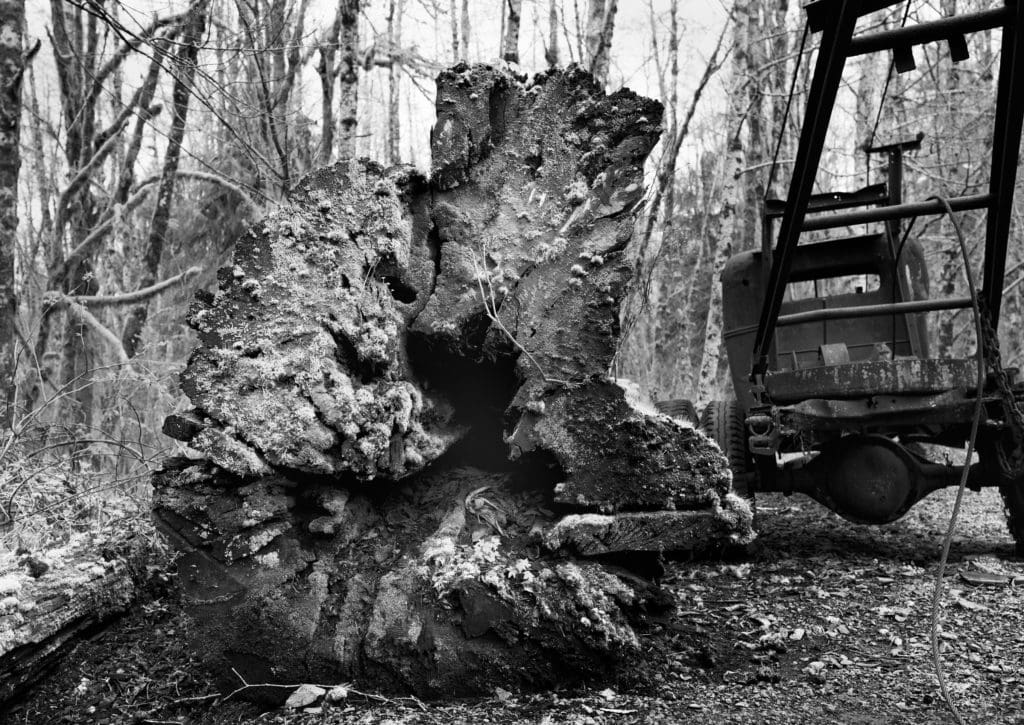 It was day four of our epic roadtrip from
It was day four of our epic roadtrip from 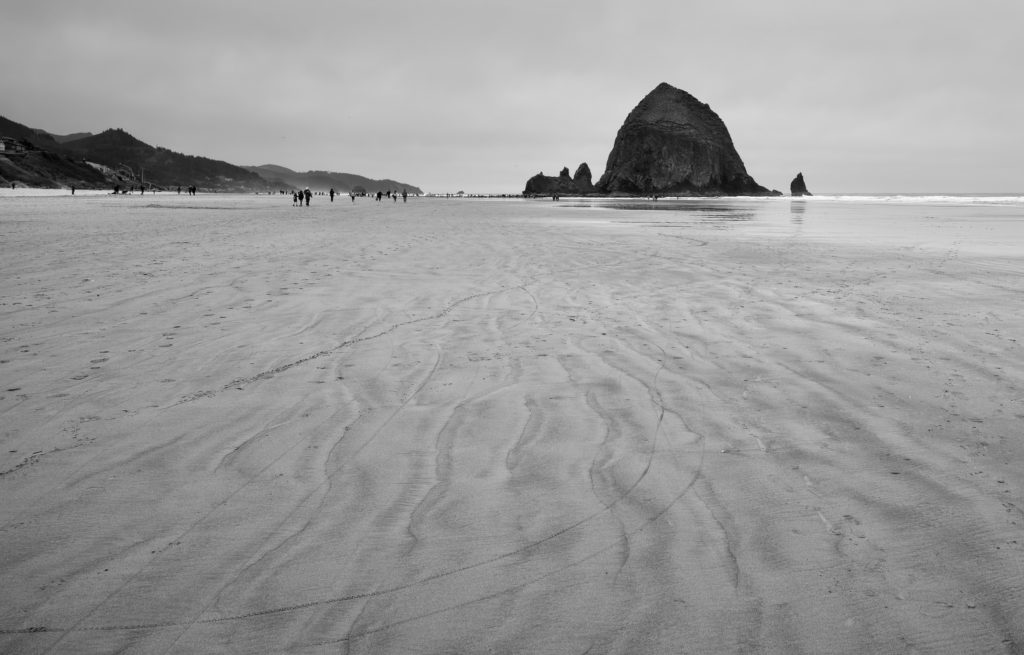 Cannon Beach
Cannon Beach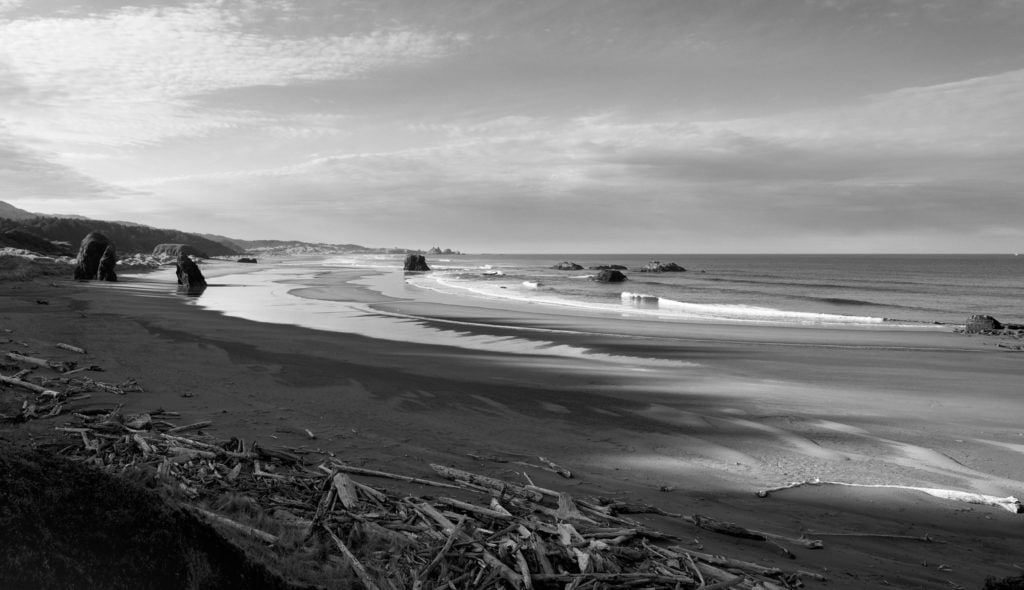 I remembered that there was a small shop some miles back towards Gold Beach, so we set off towards the town. After a few more close calls with deer we came to the Rogue River Grocery and Tavern in the apparently invisible community of Agness. As we entered the grocery, lit with an eerie yellow light quite possibly not of this earth, I noticed a large and rather disreputable looking stuffed turkey in one corner. The head had been removed at some point and glued back on, with a visible white join. The tavern was out back and in near darkness; a lone drinker sat motionless in the dark. Reviewing our our choice of ingredients for dinner we found them be be rather limited and settled on a couple of tins of spam, some burger rolls and a copious amount of assorted beer. With the certainty of eating established, albeit not very well, we quizzed the store keeper about what dining options there might be in Gold Beach. He shook his head disapprovingly. “You won’t get anything in town at this time of night. It’s all shut up now.” He spoke to us as if we had rolled in at midnight expecting dinner, but actually it was only 8.30 in the evening.
I remembered that there was a small shop some miles back towards Gold Beach, so we set off towards the town. After a few more close calls with deer we came to the Rogue River Grocery and Tavern in the apparently invisible community of Agness. As we entered the grocery, lit with an eerie yellow light quite possibly not of this earth, I noticed a large and rather disreputable looking stuffed turkey in one corner. The head had been removed at some point and glued back on, with a visible white join. The tavern was out back and in near darkness; a lone drinker sat motionless in the dark. Reviewing our our choice of ingredients for dinner we found them be be rather limited and settled on a couple of tins of spam, some burger rolls and a copious amount of assorted beer. With the certainty of eating established, albeit not very well, we quizzed the store keeper about what dining options there might be in Gold Beach. He shook his head disapprovingly. “You won’t get anything in town at this time of night. It’s all shut up now.” He spoke to us as if we had rolled in at midnight expecting dinner, but actually it was only 8.30 in the evening.